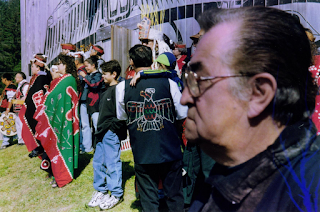Pat Alfred's Memorial Potlatch took place mid-spring 2011 in Alert Bay, B.C., and the gathering came to the Big House of the Namgis Nation on Cormorant Island. The Alfred family was preparing the Potlatch for late April or May, and the Alfreds received a lot of community support. They gave a treasure of memories and gifts in return.
The passing of Pat Alfred came as a blow to the community when he died by accident on the Inside Passage. He was 75 years old when it happened and Pat was working in the depth of a winter night as another member of a fishing crew in the herring fishery. When the herring boat called the Westisle was hauling in a catch at about midnight January 7, 2008, Pat was swept away to die by hypothermia and drowning in the waters beside Vancouver Island.
It happened because the ball of herring took off into a panicky swim and pitched the loaded vessel to its side so fast nobody wore the safety suits. Watching his crew mates struggled to gain a way out of the deadly situation, Pat Alfred, esteemed Namgis Elder, lifelong fisherman, important First Nation Canadian citizen, waved the crewmen away to their own salvation. Pat's body was found the next day on the shores of another Inside Passage island. His family and 400 mourners laid Pat to rest the following January 12th, in Alert Bay, BC..
Pat was an Elder who believed in the work of the commercial fishery in Coastal First Nations. He was known as a man who was able to preserve a vestige of a formerly prosperous occupation. He had served as an elected chief, was holder of Hereditary Title, and Pat raised a family in Alert Bay with his wife Pauline. In his life, as in his passing, the world changed under his feet, and the traditional ways of his people as gregarious and successful commercial fishers collapsed along the coast.
Before his life, his forefathers fought a secret battle to preserve Kwakwala-speaking culture. The government had outlawed their system of binding society. Potlatch preparation takes immense energy from a group known as Homatsa, a secret society of warriors whose skills include carving. Pat was never a carver. He was born in the middle of the Canadian government's effort to extinguish First Nation culture.
Pat's sons are carvers. One is Wayne Alfred, renowned master carver who exacts images of old from photographs and artifacts. Pat's grandson, Marcus Alfred, developed his skills since childhood and has become a highly proficient carver following the guidance of masters like his father, and Beau Dick. These cultural artisans are inspired by Potlatch as they carve in a language that seems to make profound statements that have no meaning to anybody but God anymore.
The world today is allowed to marvel without understanding the complexity of the sign language found on the west coast. At Pat's upcoming Potlatch the community will witness a pole-raising ceremony, Pat's memorial pole. This pole is presently being written like a Talmud that supports the oral tradition of Pat's heritage. The carvers dig into the past to make actual pieces that express great heaps of tradition knowledge. A language once removed may actually someday be restored!
In days of old the highest achievers in a Potlatch culture were artists and artisans, and the compositions were knowledge banks, like books. These compositions described who was doing what (and where they did it) for their livelihood. This region of the world was rich in processed goods long before European merchandise was traded.
The riches came from cultivating the 'tree of life' (they called it) and designing their lives around cedar and seafood. Eight Potlatch nations on the coast each had their own sets of autonomous collectives. Beau Dick, Homatsa chief, says the autonomous collectives operated like leagues, “often competitively.” A system of hereditary clan houses communicated knowledge via societies. Each of the eight nations on the coast in the Potlatch system was entirely informed of national protocols by reading things on poles, in house fronts, in chilkat blankets, and in all the forms of 'art' that was reproduced.
The art contained written identification of wealth and fiscal origins of manufactured goods. Tthis information was made available to identify the order of society, and the flow of wealth. Crests and logos adorned every piece of equipment, fishing tools, carving tools, all household items, canoes, the housefronts of the House chiefs. This part of the world developed an economy that strongly resembles the stock exchange of today through corporation development of logos and imagery identifying the money trail.
The old St. Michael's Residential School stands in Alert Bay, built in 1929. Pat was a student at the school. “The school should continue to stand,” says Wayne Alfred. “They keep Auschwitz standing as a reminder of the past.” Some of the carving for Pat's coming Potlatch is underway in the basement by carvers who work all hours of the day and night. (The rest of the haunted edifice is deserted.)
This Pat Alfred Memorial Potlatch in the Broughton Archipelago occurred as a reminder of enduring strength of those autonomous collectives that Pat came from. It occurred in the traditional home of the Kwakwala speaking nation. The Pat Alfred Memorial Potlatch lasted a couple of days and played host to a couple thousand people in the beautiful Alert Bay Big House. At that event the abilities of the Alfreds and their community to portray a thriving culture will no doubt stand out as a living testament to the life and times of Pat Alfred.











